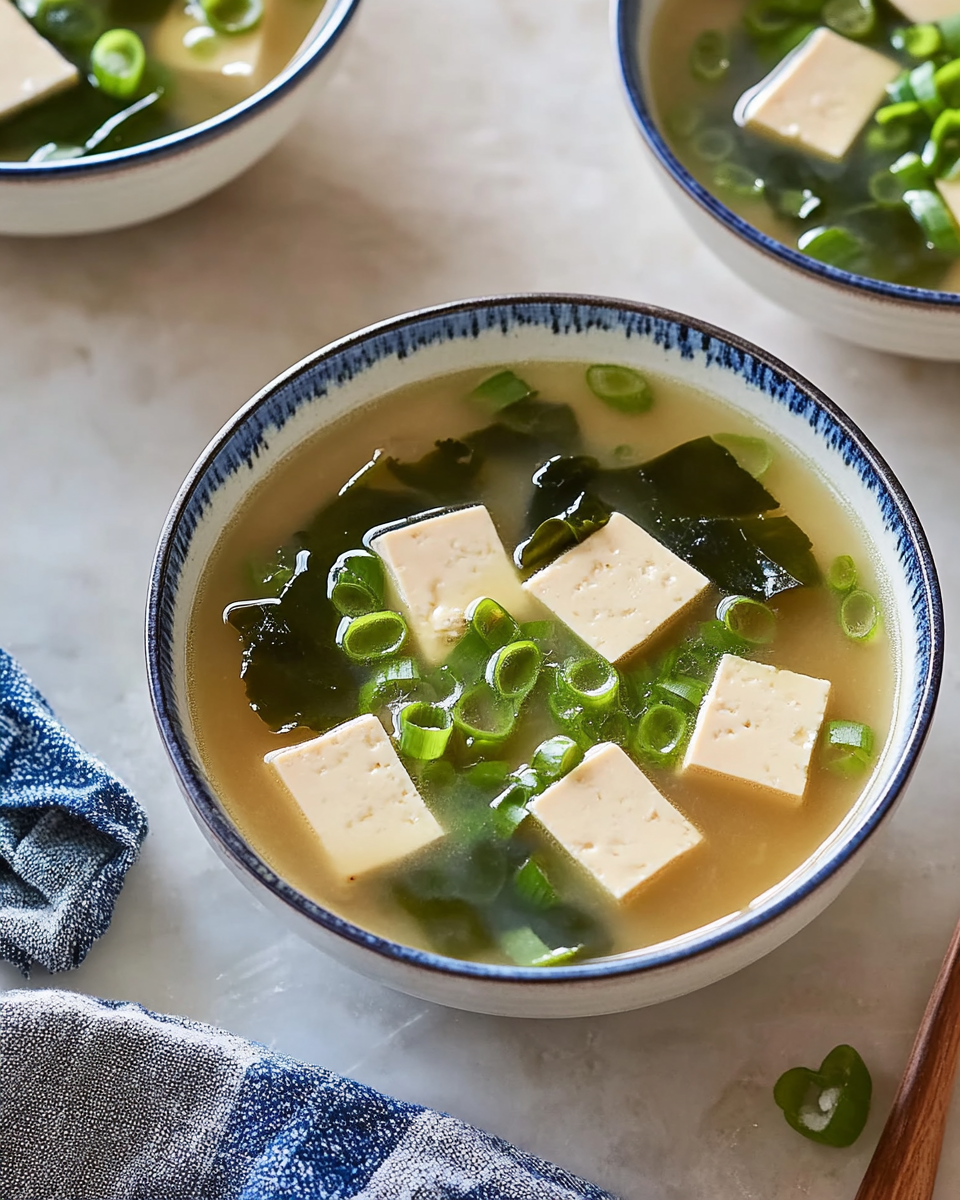This miso soup is a warm, comforting dish with the perfect balance of savory and umami flavors. Tofu adds protein, while the seaweed brings a satisfying texture, and the miso paste infuses the broth with rich depth. A simple and nourishing meal that’s ready in under 10 minutes, it’s perfect for any time of day.
The beauty of miso soup lies in its simplicity and versatility. It’s not just a starter; it can be a light meal on its own or paired with other dishes. You can easily adjust the flavor by adding more miso paste or soy sauce, and customize it by including other ingredients like mushrooms, bok choy, or even a dash of sesame oil for extra richness. This is truly a dish that fits into any meal plan while offering a taste of authentic Japanese comfort food.
Full recipe:
Ingredients:
-
4 cups water
-
2 tablespoons miso paste
-
1/2 cup tofu, cubed
-
1/4 cup dried wakame seaweed
-
2 green onions, chopped
-
1 tablespoon soy sauce (optional)
Directions:
-
In a pot, bring the water to a boil.
-
Add the miso paste and stir until dissolved.
-
Add the tofu cubes and wakame seaweed, then let simmer for 5 minutes.
-
Stir in the soy sauce if using, and top with chopped green onions before serving.
Prep Time: 5 minutes | Cooking Time: 5 minutes | Total Time: 10 minutes
Kcal: 100 kcal | Servings: 4 servings
The History and Origins of Miso Soup
Miso soup has deep roots in Japanese history, with its origins tracing back over a thousand years. Miso, the primary ingredient in the soup, has been a part of the Japanese diet for more than 2,000 years. The word “miso” translates to “fermented beans,” which is an apt description of the process used to make the paste. The paste itself is traditionally made from fermented soybeans, rice, and sometimes barley, which gives miso its distinct, savory flavor. The soup likely began as a simple dish that accompanied rice, but over the years, it has evolved into a more sophisticated and varied meal.
In ancient Japan, miso soup was consumed not just for its flavor but also for its health benefits. The fermentation process of miso helps create beneficial probiotics that promote gut health. During the Edo period (1603–1868), miso soup became a common part of daily meals in Japanese households, and it continues to hold cultural significance today. Even modern variations of miso soup, often incorporating a wide range of ingredients, remain a beloved dish in Japanese restaurants worldwide.
What Makes Miso Soup Special?
Miso soup is unique for a number of reasons. First and foremost is its depth of flavor, which comes from the fermentation of miso paste. The fermentation process gives miso a rich umami taste that is often described as savory or “meaty,” despite the absence of animal products. This makes miso soup an ideal dish for vegetarians, vegans, and those looking to reduce their meat consumption while still enjoying a deeply flavorful meal.
Another defining characteristic of miso soup is its versatility. While the traditional ingredients—miso paste, tofu, and seaweed—form the basis of the soup, miso soup can be easily customized to include other ingredients. Mushrooms, bok choy, and even sliced vegetables like carrots or onions are frequently added to elevate the dish. The soup’s simplicity and adaptability allow it to pair well with many types of food, making it an ideal side dish or even a light main course.
Health Benefits of Miso Soup
Miso soup is not only delicious but also nutritious. The fermentation process involved in creating miso paste is known to produce beneficial bacteria, or probiotics, which aid in digestion and help maintain a healthy gut microbiome. Probiotics have been linked to improved digestion, enhanced immune function, and better overall health. Because miso soup is typically made with tofu, it also provides a good source of plant-based protein, making it a perfect choice for vegetarians and vegans.
Additionally, the seaweed used in miso soup—such as wakame—contains essential minerals like iodine, calcium, and magnesium. Seaweed is also a rich source of vitamins, including vitamins A, C, and K, which support skin health, immune function, and bone health. Furthermore, miso soup is relatively low in calories, making it an excellent choice for those who are looking to enjoy a healthy meal without compromising on flavor.
Variations of Miso Soup
Though the basic recipe for miso soup remains quite consistent, there are numerous regional variations and adaptations depending on personal taste and available ingredients. In Japan, miso soup can vary based on the type of miso paste used. There are three primary types of miso paste: white miso (shiro miso), red miso (aka miso), and mixed miso (awase miso). White miso is milder and slightly sweeter, while red miso has a stronger, more pungent flavor. Mixed miso combines the two and offers a balanced taste.
The choice of miso paste can dramatically affect the flavor profile of the soup, so feel free to experiment with different types to find the one you prefer. Similarly, the ingredients can be adjusted based on your preferences. Common additions include mushrooms (shiitake or enoki), green onions, and various leafy greens like spinach or bok choy. For a heartier version, you might add noodles or rice, transforming the soup into a more substantial meal.
How to Make Miso Soup at Home
Making miso soup at home is easy and requires just a few simple ingredients. The process involves dissolving miso paste into hot water to create the broth, then adding tofu and seaweed to enrich the soup’s flavor and texture. While you can use store-bought miso paste, you can also find fresh miso paste in many Asian markets or online. If you’re making miso soup for the first time, start with a basic recipe and gradually explore variations to find the flavor combinations you enjoy most.
When making miso soup, one key tip is to avoid boiling the soup after adding the miso paste. Miso paste is delicate, and boiling it can cause the broth to become bitter. Instead, once the paste is dissolved in the hot water, lower the heat and allow the soup to simmer gently. This will help preserve the delicate flavors and prevent the soup from becoming too salty or overwhelming.
Serving Suggestions and Pairings
Miso soup is a wonderfully versatile dish that pairs well with a wide variety of meals. Traditionally, it is served with steamed rice and other Japanese side dishes such as pickled vegetables, tempura, or sushi. The savory flavor of miso soup makes it a great complement to rice, as the broth helps cleanse the palate between bites of rice or other dishes.
Miso soup also works beautifully as a starter or accompaniment to a more substantial meal. It can be served alongside grilled fish, chicken teriyaki, or a vegetable stir-fry for a well-rounded and satisfying meal. For those who prefer a lighter meal, miso soup can be enjoyed on its own as a quick lunch or dinner. The simplicity of the dish makes it a great option for busy weeknights or when you’re in the mood for something light but flavorful.
Conclusion
In conclusion, miso soup is a timeless dish that has become a beloved comfort food worldwide. Its rich umami flavor, nourishing ingredients, and health benefits make it a perfect addition to any diet. Whether you enjoy it as a light snack or a starter for a more elaborate meal, miso soup offers versatility and depth that is hard to match. Its simple preparation and ability to be customized to suit different tastes and preferences ensure that it remains a staple in kitchens everywhere.
Whether you’re seeking a warming meal on a cold day or just want to enjoy a taste of authentic Japanese cuisine, miso soup is sure to satisfy your cravings. So, grab your miso paste and tofu, and get ready to enjoy this delicious and nutritious bowl of comfort!






